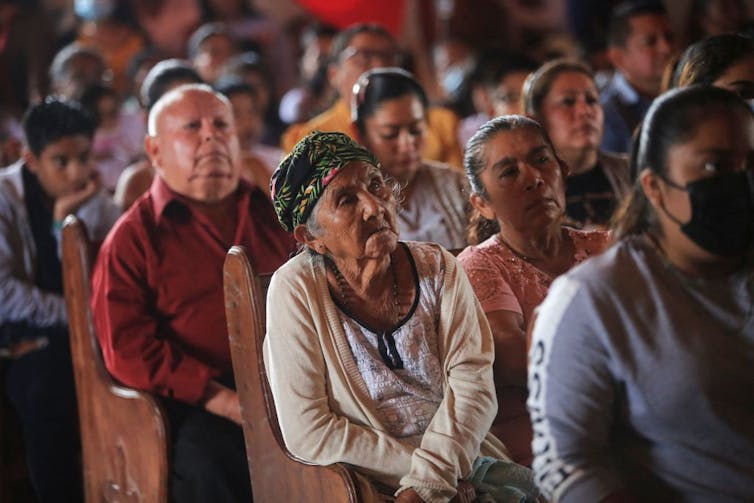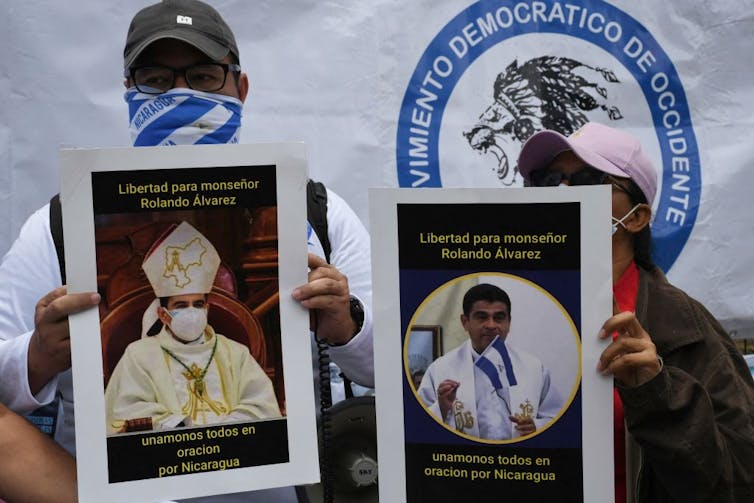Nicaragua released imprisoned priests, but repression is unlikely to relent – and the Catholic Churc
When President Daniel Ortega returned to power in 2006, church figures supported him. Violent repression after the 2018 protests has soured the relationship and made clergy targets for intimidation.

Bad news has been the norm for Catholics in Nicaragua, where clergy and church groups have been frequent targets of a wide-ranging crackdown for years. But on Jan. 14, 2024, they received a happy surprise: The government unexpectedly released two bishops, 15 priests and two seminary students from prison and expelled them to the Vatican.
Those released included Bishop Rolando Álvarez, a high-profile political prisoner who was detained in 2022 for criticizing the government and then sentenced to 26 years in prison for alleged treason.
They also included priests detained by President Daniel Ortega’s government in late December 2023 for expressing solidarity with Álvarez and other political prisoners. Days later, Pope Francis criticized the regime in his New Year’s message and then called for “respectful diplomatic dialogue.”
Nearly six years after mass protests erupted against Ortega and then were brutally repressed, these prisoner releases offer some hope to Nicaragua’s opposition. As my research has shown, however, the Ortega regime is unrelenting in trying to retain power, which suggests this is not necessarily a turning point. In fact, the government reportedly took yet another priest into custody on Jan. 16.

Why target the church?
Ortega first led Nicaragua from 1979 to 1990, after his left-wing revolutionary organization, the Sandinista National Liberation Front, or FSLN, spearheaded the overthrow of dictator Anastasio Somoza Debayle. In the 1980s, the FSLN clashed with the Vatican and church hierarchy over the group’s socialist politics, even as many poorer Nicaraguan Catholics embraced them.
When Ortega took office again in 2007, however, he did so with the blessing of Christian leaders. During the 2006 elections, he had turned to alliances with Catholic and Protestant elites to return to power in exchange for adopting conservative social policies like banning abortion.
Over the next decade, Ortega remained popular, presiding over economic growth in collaboration with business leaders and developing new public infrastructure and services.
Yet he and the FSLN party he controlled were also consolidating power and governing in an increasingly authoritarian manner. Ortega won reelection in 2011 and then retained power in fraudulent elections in 2016. Opposition candidates were disqualified, and Ortega’s running mate was his wife, Rosario Murillo.
Unexpectedly, Ortega’s popularity and his relationship with the church came crashing down in April 2018, when the government announced cutbacks in social security benefits for retirees. Nicaraguans from all backgrounds took to the streets, and Ortega and Murillo responded with a furious crackdown, unleashing police and pro-government paramilitaries armed with military-grade weapons.
Cathedrals and churches tried to offer refuge to protesters, but over 300 people were killed. Church leaders facilitated a national dialogue between the government and an opposition coalition, but withdrew as repression continued.
When popular Catholic leaders criticized violence against protesters, the regime began viewing the church as a rival threatening Ortega’s waning legitimacy. Police, paramilitaries and FSLN supporters started harassing and attacking clergy and Catholic institutions.
In 2019, the pope recalled Silvio Báez, the auxiliary bishop of Managua and a prominent critic of Ortega, from Nicaragua. Yet other bishops and priests still found themselves in the regime’s crosshairs.

Some fled into exile or were blocked from entering Nicaragua if they traveled abroad. Others who stayed were kept under surveillance. Priests who expressed support for political prisoners or continued to criticize the regime, even in vague terms, could be arrested or beaten.
The government expelled 12 formerly detained priests to the Vatican in October 2023 after what the regime called “fruitful conversations.” But Álvarez, the highest-profile political prisoner, was still held by the government and was stripped of his citizenship after refusing to go into exile in February 2023.
Broader patterns of repression
Attacks on the church are a symptom of the Ortega regime’s absolute intolerance for dissent.
With over 3,000 nongovernmental organizations shut down since 2018, the church has become Nicaragua’s only major nonstate institution with nationwide reach.
In a country where over 40% of the people identify as Catholic, many normally turn to the church in times of need. Suppressing Catholic institutions means Nicaraguans must turn to the state for aid, which monitors citizens and has been accused of denying services for perceived disloyalty.
At least 27 Catholic and secular universities have also been closed or seized by the government, as have more than 50 media outlets.

The government’s decision to expel clergy on Jan. 14 is also in line with its tendency to either block opponents’ reentry into Nicaragua or force them into exile. In many cases, Nicaragua has then revoked critics’ citizenship, as when it expelled 222 political prisoners in February 2023 to the United States.
When imprisonment or threats have not shaken critics’ resolve, Ortega and Murillo appear to have decided that keeping them abroad is best. Not only does this reduce the risks of anti-regime action in Nicaragua, but it may diminish international scrutiny of political prisoners’ mistreatment.
Cautious criticism
Since 2018, repression in Nicaragua has come in waves, with the brutal violence that repressed the protests shifting toward an environment of constant surveillance, legal actions against independent institutions and opponents, and periodic arrests. Moments of seeming calm, however, have often been followed by harsh crackdowns, such as a slew of arrests ahead of the 2021 elections.
Even as repression has mounted, the Vatican has been cautious about criticizing Ortega and Murillo, and some Nicaraguans and Catholics abroad have urged the pope to do more. Yet the Vatican’s restraint has not appeared to decrease threats against clergy or limits on activities like religious processions.
In January 2024, however, Francis pointedly called attention to the crisis during two speeches, days after a dozen priests were arrested. One week later came the release of Álvarez and his colleagues – free to leave Nicaragua, but not to come back.
Catholic leaders remain Nicaragua’s most popular figures, according to independent polling. This makes them a continued threat to Ortega and Murillo’s quest for total control. Ezequiel Buenfil Batún, the priest detained Jan. 16, belonged to a religious order whose legal status was revoked that same day, along with several other nongovernment organizations.
As many Nicaraguans lose hope of conditions improving and dozens of political prisoners remain jailed, any positive news like the priests’ release is welcome. But it holds no guarantees of broader change ahead.
Kai M. Thaler does not work for, consult, own shares in or receive funding from any company or organization that would benefit from this article, and has disclosed no relevant affiliations beyond their academic appointment.
Read These Next
How the ‘slayer rule’ might play a role in determining who will inherit wealth from Rob Reiner and h
These rules have a long history in the United States. They played a role in the notorious murders by…
The celibate, dancing Shakers were once seen as a threat to society – 250 years later, they’re part
‘The Testament of Ann Lee,’ Mona Fastvold’s 2025 film, depicts part of the long history of Shaker…
As DOJ begins to release Epstein files, his many victims deserve more attention than the powerful me
Powerful men connected to Jeffrey Epstein are named, dissected and speculated about. The survivors,…






